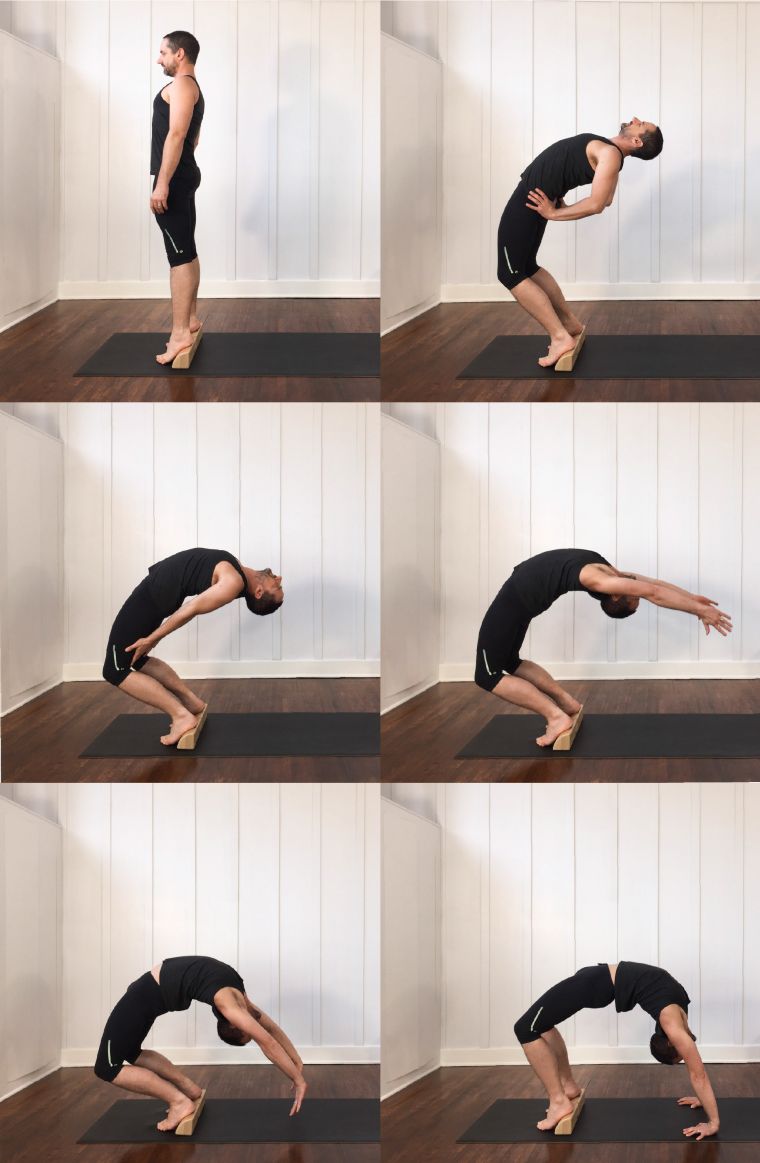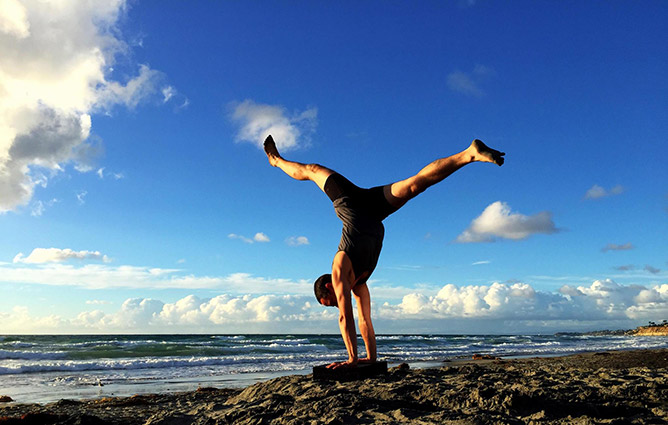YOGAMAZÉ ASANA: Struggling With Dropbacks? Try High Heels! with Noah Mazé
Dropping back from standing into urdhva dhanurasana (upward facing bow, aka wheel pose) is a difficult transition for a number of reasons. Let’s examine just a few of these challenges, along with some practice strategies to address them—including, yes, trying this tricky transition with high heels.
Why is this transition hard? It’s scary! In my experience, some fear is warranted, and it’s a natural and helpful response. The fear tells you: Pay attention. Be careful. It’s important to stay safe. If you think about it, you are intentionally bending over backward, and you cannot really see where you are going. Metaphorically, you are going into the darkness, into your shadow, into the unknown. Physically, there is the very real possibility of falling on your head.
Why is this transition hard? It’s scary! In my experience, some fear is warranted, and it’s a natural and helpful response.
In the face of fear, cultivate courage. Let courage dialogue with fear, and if fear’s voice is louder, listen to it and adjust accordingly. Don’t transgress that boundary; there is no benefit gained from forcing this transition if your somatic experience is saying no.
A Common Challenge
Too much impact: The tighter your relevant joints and muscle groups, the less deeply you will be able to backbend from standing. This means that the height from which you’ll “drop” back into urdhva dhanurasana will be greater, increasing the force of impact. To decrease the impact, you might consider raising the “floor” by dropping back to the wall or a slanting board so that you do not have as far to go.
The Importance of Careful Preparation
In a general sense, your preparation should include poses to lengthen your hip flexors, open your shoulders, mobilize your thoracic spine for extension, stabilize your lumbar spine, and strengthen your hip extensors. Because of all the preparation involved in approaching the dropback, much less achieving it, many of us consider this transition worthy of being designated the “peak pose” of a sequence.
So What About the High Heels?
Besides tight joints and/or muscles, sometimes the limiting factor in the standing backbend is the ankles. You may experience a lack of dorsiflexion mobility, which can be evident in a lifting of the heels and/or turning out of the feet just before dropping back. Sometimes heel lifting and/or feet turning out is caused by what is happening higher up the chain at the hips—some combination of tight hip flexors, overactive external rotators, underactive adductors, or weak internal rotators. However, it is not always those things; sometimes it can be due to a lack of ankle mobility.
In addition to lengthening the muscles of the calf (the soleus and gastrocnemius) in your sequencing, try putting a prop (a tightly rolled blanket or extra yoga mat) under your heels for the standing backbend. This will have the effect of decreasing the amount of ankle dorsiflexion required and will probably increase the flexion in your knees so that you can get lower to the floor (Remember playing limbo? “How low can you go?”) in your standing backbend, allowing for a softer “drop” into your dropback.

In these photos, I am elevating my heels with 1/4 round blocks, but you can get a similar effect elevating your heels with a tightly rolled blanket or yoga mat.
Two notes of caution:
1. The prop under your heels changes the base of support and can make the pose feel less stable. The firmer the prop, the better—the softer and squishier the prop, the less stable it will feel. Experiment with different prop options and different degrees of lift under your heels.
2. Dropping back is quite a bit easier than standing back up to tadasana (mountain pose). I recommend that you gain proficiency in dropping back with “high heels” and use a skillful spotter, if needed, long before you attempt to stand up with the prop under your heels. Perform the dropback with high heels and then lower yourself to the floor, turn to your side, and stand up. Repeat.
And one footnote (pun intended): I personally have not tried this with high-heeled shoes or boots as I do not own any, and my wife’s shoes are too small for me. But I imagine that such shoes would have the same effect as putting a prop under your heels. For those of you who are so inclined, give it a try and let me know how it works. Perhaps I’ll go shoe shopping!
Editor’s note: For a complete yoga practice leading up to dropbacks, check out Noah’s classElastic Strength: Deepen Your Backbends.
